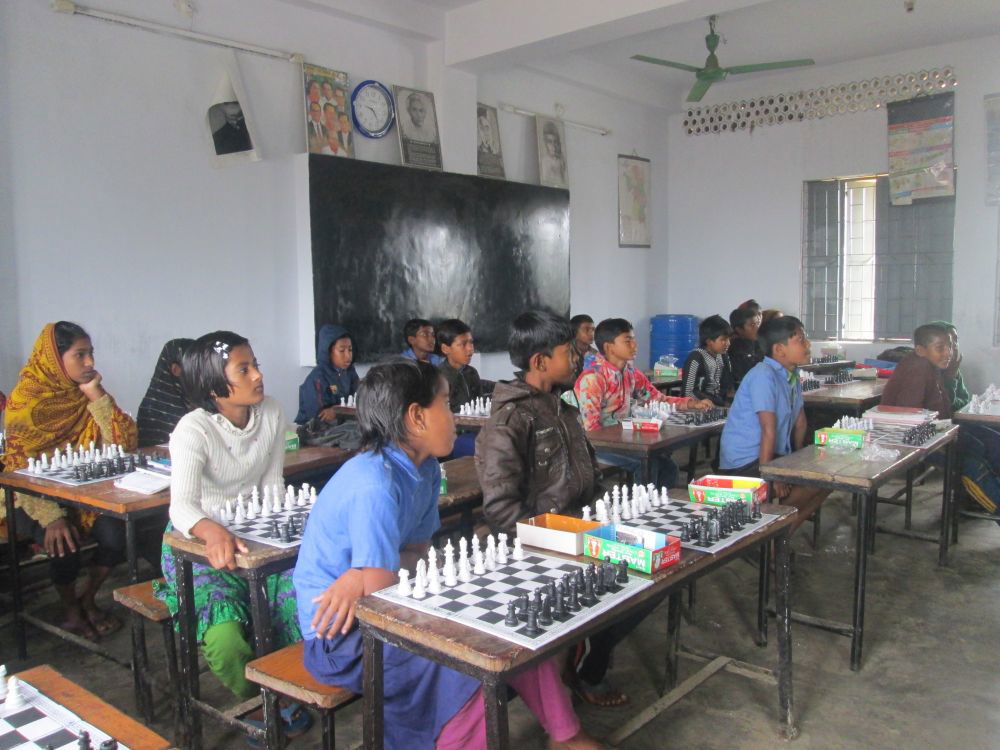The first question that comes to mind is the meaning of the term “Strategy”. In Chess, there are largely two approaches that help the player to understand the situation on the board.
Suppose if in a position, the game is about the weak pawns, islands, pawn structure, imbalances like space, good and bad minor pieces, holes, then it means, the player needs to play “Positional Chess”.
The Imbalance theory, Improving pieces, prophylaxis and the drawback principle are the best ways to understand and play positional chess. Below is an example of a middle game that has to be played with “Positional Chess approach”.
white to play
In the above mentioned example, you can notice the following things:
- There is a difference in minor pieces. Black has a dark squared bishop which is a bad bishop and white has a knight which needs to be maneuvered to make it powerful.
- The pawn structure shows that d6 is a backward pawn on a semi open file which becomes a weakness. Also, there are a lot of holes present in the 5th and 6th rank. We know that holes are nothing but home for minor pieces.
- White has the space advantage and we know that the side who has the space advantage should not exchange pieces rather they should try to improve their pieces.
- By applying the above ideas, we can understand that white knight needs to be improved from c1 square ( Undeveloped knight ) to e6 square ( Octopus knight ).
- So the moves can be -> Nd3 -> Nf4 -> Ne6!
- This is the positional way to play chess.
Strategy is different from positional chess in many ways:
- In positional chess, you can take time to improve your position, while in strategic chess, if you don’t find the best move right now, then you will have to give away the advantage.
- In positional chess, you think more about pawn weaknesses like isolated pawn, backward pawn, pawn structure in general, while in strategic chess, you think about the different types of pieces. The different types of pieces are Underprotected pieces, Unprotected pieces, Overprotected pieces and Hanging pieces.
- In positional chess, you have to apply the imbalance theory to assess the position while in strategic chess, you need to look for Checks, Captures and threat moves.
- Positional chess can be both static and dynamic while strategic chess is only dynamic in nature.
- Solving puzzles and finding tactics form the basis of strategic chess while understanding pawn structures, creating weakness, studying about good and bad minor pieces form the basis of positional chess.
Now let’s take another example:
Black to play
The above position is a very dynamic position. I will explain the reason behind it.
Black has to find the best move and there is only one move that works for black. Rest everything is winning for white.
- Suppose you start with Rb8. Rb8 looks like a very natural reply but in strategic chess, you cannot overlook the opponent’s options. You need to understand the types of pieces you are dealing with. A normal move like Rb8 can turn the tables and is fatal for black. White can play Ne7+ and win the game.
- Another option comes to mind is Bh3 but the moment you see Qxa8+ and then Ne3 saving the checkmate on g2, you understand that it’s not the right idea.
- So how should we solve the above problem? In strategic chess, it’s important to understand the types of pieces you are dealing with.
In strategic chess, there are 4 types of pieces:-
- Overprotected pieces – n(a) < n(d)
- Under protected pieces – n(a) = n(d)
- Unprotected pieces – n(a) > n (d)
- Hanging pieces- Neither attacked nor protected.
n(a) = Number of attackers
n(d) = Number of defenders
For our simple understanding-
- If the number of attackers > number of defenders, the piece is an Unprotected piece.
- If number of attackers = number of defenders, the piece is an Underprotected piece.
- If number of attackers < number of defenders, the piece is an Overprotected piece.
- If the piece is neither attacked nor defended, the piece is hanging.
In the above example,
For White :
- Pawn on g2 is underprotected.
- Knight on d5 is unprotected.
- Queen on b7 is hanging.
For Black :
- Rook on a8, Knight on c6 are Unprotected.
- Bishop on e6 and Queen on g5 are hanging.
We now understand that something needs to be done around the above mentioned pieces. We can calculate that if we go for Bxd5, we are threatening Qxg2# in the next move.
So after Bxd5, white can take our rook but can you find the next best move? It is Nd8! Saving the check, counter attacking the Queen and threatening the checkmate.
That is the best way to solve positions. This is the strategic approach to chess.
REMEMBER: Solving puzzles lay down the foundations for your strategic chess.
To answer the question of how to solve puzzles, here is one simple approach that you can follow.
Whenever you look at any position, calculate in this sequence: Check, capture, threat. (Easier said than done)
- Checks
- Puzzles under 1000 ratings = Usually there are only 1 check move and that is the right answer.
- Puzzles between 1100-1500 ratings = Usually there are multiple checks- Use Elimination technique. Calculate each check and see if it works. If it doesn’t work, eliminate that option.
- When you are calculating checks, try to calculate till the end.
- To find checks, see the opponent’s king and try to find out the directions in which the king is exposed.
- Capture
- If the puzzle is not solved by checks, you need to now look for captures. The biggest mistake players do while calculating captures is that they cannot resist the temptation of playing the first capture move that comes to mind. This is something you have to work on.
- Focus on Under Protected, Unprotected pieces and hanging pieces. Something will be going on around these pieces.
- Once you find out the pieces around which the puzzle is created, calculate different lines. See which line is giving you the best outcome. Try to understand “ what is going on “ in the puzzle.
- Tactics will not happen around over protected pieces.
- Threats-
- If the answer is not in capture, it is bound to be in threat.
- By the time you will come to the threat option, you would have understood “ what is going on “ and “ what are we trying to achieve “.
- You need to create threats by attacking pieces that are either unprotected, Underprotected, hanging, or can change into these types of pieces once attacked.
- With practice, you will be able to create threats in the above mentioned manner.
Always remember : Solve puzzles to understand the approach. The moment you see any puzzle, don’t try to look for answers directly. Rather, one should first try to understand the puzzle, let the placement of pieces, types of pieces involved, sink in. Once you allow yourself time to look for these details, you will enjoy solving puzzles more and more.
Let’s take another example:
In the below mentioned position, take your time and try to find out the different types of pieces involved. It is black to play and there is no check move possible, so we will directly move into captures.
Try to understand the type of piece the queen is, the type of piece the a2 pawn is.
Black to play
What did you come up with?\
- Should I take the Queen?
- Should I take the a2 pawn?
First of all, we have to understand that there are two kinds of pieces involved in this situation :
- White Queen is an underprotected piece. [ n(a) = n(d) ]
- The pawn on a2 is an unprotected piece. [ n(a) > n(d) ]
So something is happening around these two pieces.
- Taking the Queen on d6 is not the right approach as black is already down 2 pawns and after Qxd6, Rxd6, Rxa2, Rhd1, white stands better as white will still be 1 pawn up.
- Lets now calculate Rxa2
- Rxa2, if Qxd8, there is Ra1+, Kd2, Rxd8+, Ke2 and Nf4+ and you win the d1 rook
- Rxa2, if Qd5. there is Ra1+, Kd2, Nf4! Now Qxd8, Rxd8+ and we still win the rook. Notice how Nf4 in this line is a “ threat move “.
This approach, in my opinion, will give you clarity of thought and your understanding about Strategic chess will improve a lot!
Thanks
Keep playing.

